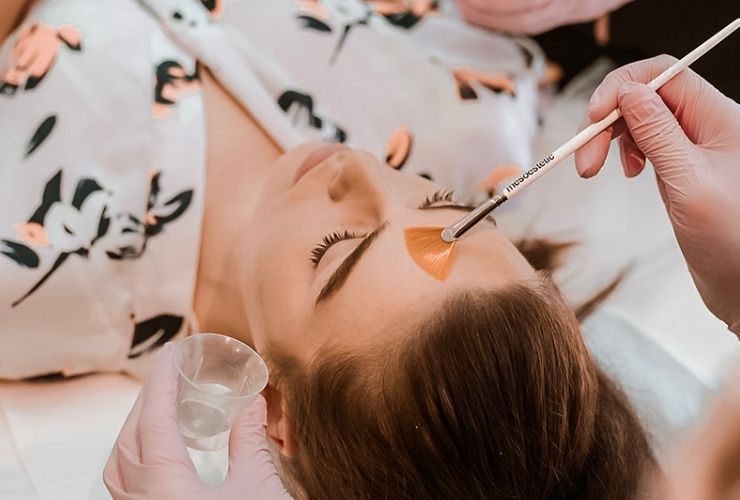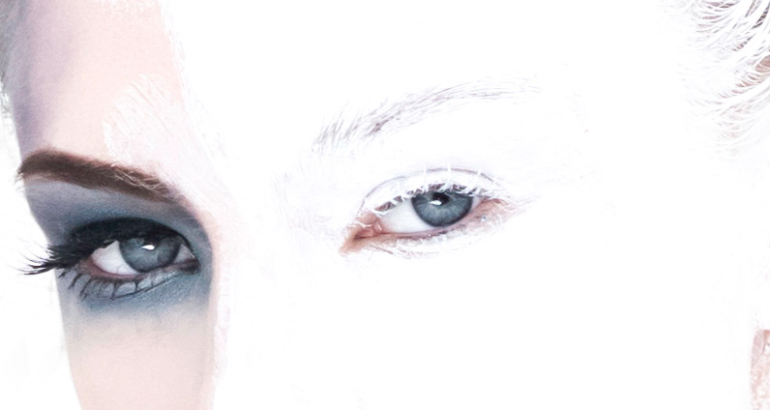by Skincare Specialist, Bianca Jansen
At some point in our lives, we all experience skin concerns that can make us feel self-conscious. You may go through stages of rough, uneven skin texture, acne, breakouts, or pigmentation. Luckily, you shouldn’t feel like you have to hide your skin and imperfections – especially when there are completely customisable chemical peels that can improve your skin appearance and restore your skin’s health!
Table of contents
- WHAT IS A CHEMICAL PEEL?
- WHAT ARE THE DIFFERENT TYPES OF CHEMICAL PEELS?
- WHAT INGREDIENTS ARE USED IN CHEMICAL PEELS?
- WHAT SKIN CONDITIONS CAN BE TREATED WITH CHEMICAL PEELS?
- ARE CHEMICAL PEELS SAFE FOR SENSITIVE SKIN?
- ARE CHEMICAL PEELS SAFE DURING PREGNANCY?
- ARE CHEMICAL PEELS SAFE FOR DARK SKIN?
- HOW LONG AFTER A PEEL WILL I SEE RESULTS?
- DOES A CHEMICAL PEEL WORK IF MY SKIN DOES NOT PEEL AFTER?
- CAN CHEMICAL PEELS BE COMBINED WITH OTHER SKIN CARE TREATMENTS?
- HOW MUCH DO CHEMICAL PEELS COST?
- OUR APPROACH TO CHEMICAL PEELS
WHAT IS A CHEMICAL PEEL?
A chemical peel is a skin resurfacing treatment intended to remove the outermost layers of the skin, there are various chemical solutions that can be used depending on the indication or condition we are targeting.
WHAT ARE THE DIFFERENT TYPES OF CHEMICAL PEELS?
Chemical peels can be broken down into three categories. Superficial, medium, and deep.
Superficial chemical peels
Superficial chemical peels are the most common and generally the most gentle on the skin, they can also be used the most frequently and work by exfoliating the outermost layer of the skin – called the epidermis, they are used to address concerns such as uneven skin tone and texture, fine lines, breakouts, and post-inflammatory acne lesions).
Medium-depth chemical peels
These chemical peels can penetrate the skin slightly deeper than a superficial peel and they work on the middle layer of the skin, they are able to penetrate through the epidermis to the papillary dermis. These peels stimulate the skin’s regeneration process by stimulating collagen and elastin.
Deep chemical peels
Deep chemical peels can penetrate the deeper layers of the skin causing a resurfacing action, they reach the reticular dermis and cause extensive skin exfoliation. Deep peels are used to treat severe sun-damaged skin and deep lines and wrinkles.
WHAT INGREDIENTS ARE USED IN CHEMICAL PEELS?
Glycolic acid
This is an alpha hydroxy acid derived from fruit, it has a small molecular structure, which means it can penetrate quickly into the skin. There are a variety of intensities ranging from superficial to deep, glycolic acid is mostly used for its anti-aging benefits.
Mandelic acid
This is an alpha hydroxy acid derived from bitter almonds, mandelic acid has a larger molecule, twice the size of glycolic acid which makes it ideal for sensitive skin,
Lactic acid
This organic compound (found in fermented milk) is derived from sugar or vegetable sources. Lactic acid tends to be more tolerable on sensitive skin than other acids. It helps boost the skin’s natural moisture factors, helping to keep skin hydrated and plump.
Azelaic Acid
Azelaic acid is a naturally occurring acid found in rye, barley, and wheat. It has anti-inflammatory and antimicrobial properties, used to effectively treat rosacea and acne.
Tranexamic acid
This acid comes from the amino acid lysine and is mostly used as a brightening agent to reduce hyperpigmentation, melasma, and post-inflammatory hyperpigmentation.
Salicylic acid, a beta-hydroxy acid(BHA)
Derived from willow bark, these are natural antimicrobial ingredients and are known for their ability to exfoliate, control oil and reduce inflammation. BHA’s can help with breakouts and clogged pores, it is an oil-soluble compound that addresses sebum and acne-causing bacteria.
WHAT SKIN CONDITIONS CAN BE TREATED WITH CHEMICAL PEELS?
Uneven skin tone and skin texture, melasma, breakouts and acne, age spots, fine lines and wrinkles, sun damage, and rosacea can all be successfully and safely treated with chemical peels!
And let’s not forget about ageing skin! Natural skin rejuvenation slows down as we age, skin cells take longer to turnover, and hyaluronic acid production slows down, fine lines begin to form and the complexion becomes dull. Aging skin regenerates less efficiently than younger skin, mainly due to the slow production of collagen and elastin, Chemical peels help to speed up the regeneration process in turn boosting collagen and elastin production to reduce the appearance of fine lines.
ARE CHEMICAL PEELS SAFE FOR SENSITIVE SKIN?
When treating sensitive skin, it is important to first assess what is causing the sensitivity. For example, many people use the incorrect home care products (ones that are too strong and active) which results in sensitised skin. If this is the case, treatments to help repair the skin’s barrier are key before proceeding with chemical peels.
For chronic conditions such as rosacea, chemical peels are safe depending on the health of the skin’s barrier and the skin’s level of dryness.
ARE CHEMICAL PEELS SAFE DURING PREGNANCY?
Unfortunately, no. During pregnancy, breakouts, acne, and pigmentation of the skin are commonly experienced mainly due to pregnancy hormones. Although these concerns are usually treated with chemical peels, during pregnancy chemical peels are not recommended.
During pregnancy certain hormones are elevated which leads to an involuntary inflammatory response, therefore a chemical peel will not be recommended because the skin response is so unpredictable during this time. Furthermore, increasing the skin’s sensitivity by applying a chemical during this time may cause additional irritation and breakouts.
For most women, skin concerns experienced during pregnancy do not last long. After pregnancy, if the skin conditions persist, chemical peels can then be used to treat the skin condition. It is also important to allow the body enough time to restore normal hormone levels and for the skin to normalise after pregnancy.
ARE CHEMICAL PEELS SAFE FOR DARK SKIN?
We all have the same melanocytes (the cells that produce melanin) but people of colour produce a lot more melanin at the surface level, which means the risk of post-inflammatory hyperpigmentation is greater in darker skin types. Therefore, not all peels are safe for darker skin types. There are however chemical peels available that are perfect for use on dark skin! It all depends on the type and strength of the acid used, and the quality of the skin.
We, therefore, advise all new patients to have an in-depth skin analysis prior to having a chemical peel to ensure that the correct peel is used for your skin.
HOW LONG AFTER A PEEL WILL I SEE RESULTS?
Results depend on the skin’s health, skin type, and homecare products used. Because the main function of a chemical peel Is to exfoliate, improvement in the skin’s tone and texture can be seen after just one treatment.
For those who have moderate to severe concerns, and for those who have chronic concerns like acne, melasma, or rosacea, it may take more than one peel to see the desired results. The strength, type, quality, and PH of the peel that is used also play an important role in how effective the treatment is and when results can be expected.
Results are also dependent on how well you take care of your skin after your treatment. In order to see optimal results, and to maintain these results, the correct home care products are essential after a chemical peel.
DOES A CHEMICAL PEEL WORK IF MY SKIN DOES NOT PEEL AFTER?
If your skin does not peel after your treatment, don’t worry – it does not mean the treatment is not working. The healing process varies from person to person and there are various factors that can influence how your skin responds.
For superficial peels, there is usually no “downtime”. The skin can feel slightly dry for 1 – 2 days post-treatment, with a rough feeling to the touch.
Medium-depth chemical peels are slightly more invasive. You may experience a heated sensation and the skin may appear pink for 2 days post-treatment. Tightness and dryness will usually start from day 2 or 3. Flaking will usually begin from day 3 or 4 and can continue for up to 1 week after your treatment.
Deep chemical peels are the ones that require downtime. For about one week, the skin will appear red and swollen post-treatment. Peeling usually starts from day 3 or 4 and can last 1 to 2 weeks thereafter.
Here are some other factors that influence the peeling process:
Home care products
If you are using active ingredients in your home care routine such as vitamin A, retinol, and vitamin C, you may experience less peeling or flaking.
Formulation and concentration of acid
All chemical peels are formulated differently, some peels will cause slight skin flaking while others can lift off skin in layers. The extent of skin peeling will depend on what kind of acid is used during the treatment.
Depth of the peel
Different peels can reach different depths in the skin, and the percentage of the acid used will affect how much peeling is experienced, the higher the acid concentration the more the skin will peel.
Application of the peel solution
Medium-depth TCA peels are layer-dependent, based on your skin needs and goals your skin specialist will decide how many layers to apply during the treatment, this will be based on the skin’s sensitivity level as well as how your skin is responding during the treatment. The more layers that are applied the more peeling to expect.
CAN CHEMICAL PEELS BE COMBINED WITH OTHER TREATMENTS?
Absolutely! Chemical peels can be combined with other treatments to further enhance results. At Dr. Nerina Wilkinson + Associates, we include chemical peels in quite a few of our signature skin clinic treatments. The skin-lifting and tightening FormaHydraLyft, the skin-brightening Glow Getter, and the more intensive rejuvenating I-PEEL-L Bespoke are just a few.
When having a treatment that includes a chemical peel with other modalities, please always ensure that it is done by a professional who has a deep understanding of the skin.
HOW MUCH DO CHEMICAL PEELS COST?
At Dr. Nerina Wilkinson + Associates, chemical peels range from R1150 – R3050. The cost depends completely on the type of peel used and the type of treatment scheduled. You will however be quoted on your skin’s needs after your initial consultation.
OUR APPROACH TO CHEMICAL PEELS
You will always start with an in-depth VISIA skin analysis and consultation with one of our Skincare specialists. During this time, your specific skin concerns and conditions are assessed and discussed in detail and a bespoke treatment plan is designed to suit your skin’s specific needs.
Should you be ready to make a change, email us at skinclinic@drnwilkinson.co.za to start your Skin Science journey to radiance today.
Written by Skincare Specialist, Bianca Jansen





